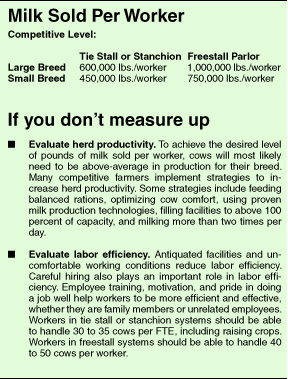The prolonged depressed milk prices in the dairy industry are creating critical cash-flow and long-term survivability issues on Ohio’s 3,328 dairy farms. Cost-cutting decisions must be made with full awareness of both short- and long-term production and economic consequences.
Many farms are analyzing every aspect of their business to see where money can be saved. The cost of labor and its impact on the overall cost of production, means a dairy manager needs to measure, evaluate, and monitor labor efficiency.
Measuring sticks
An excellent way to accomplish this is by calculating the pounds of milk sold per full-time worker. This efficiency factor combines labor efficiency and dairy herd productivity into a single indicator.
The calculation of this measure is significantly influenced by your definition of a full-time equivalent worker (FTE). In Ohio, a FTE for dairy farms is often defined as an adult who works 50 hours per week for 50 weeks (allowing two weeks of vacation per year). This translates into 2,500 work hours for each FTE.
It is vital you include all paid and unpaid labor in this calculation. Most dairy farms are more likely to have some unpaid family labor from a spouse, children, or the operator who likely works more than 2,500 hours per year.
How to calculate
To calculate milk sold per worker:
1. Calculate total FTE on the farm per year. Divide total hours of paid and unpaid labor for producing your dairy’s feed crops and for operating the dairy herd by 2,500.
2. Divide total pounds of milk sold by total FTE per year.
Total pounds of milk sold should be taken from the milk checks. Herd average figures from dairy record systems are not an accurate reflection of milk sold because they include fresh cow milk, milk discarded from treated cows, and milk fed to calves.
The pounds of salable milk fed to calves should be added to pounds of milk sold to reflect total potential milk sales.
Productivity
Pounds of milk sold per worker is an important tool for evaluating the productivity of workers and cattle. It combines efficient labor utilization with good to excellent herd production.
If all feed is purchased, the general rule is to double these benchmarks. Because freestall parlor systems can handle more cows, these systems allow more pounds of milk per year per worker than tie stall or stanchion systems.
Tie stall or stanchion barns entail considerably higher costs per cow than large, modern freestall facilities. The combination of lower investment per cow and more efficient labor utilization make freestall parlor systems much more economical, because they generally result in lower costs for producing each unit of milk.
However, existing tie stall or stanchion facilities may be able to compete with freestall parlor systems if the operation carries little or no debt. (See related chart for competitive levels of milk sold per worker.)
Efficiency
Fewer pounds of milk per worker will likely be sold per year for small vs. large breed herds, but the value of the milk sold per year may be similar under similar management systems. This can occur because of the higher value per hundredweight of milk for the small breeds of dairy cattle (milk is higher in concentration of fat and protein).
However, because the value of milk sold is affected by milk price fluctuations, it is not very useful for measuring labor productivity trends over time.
Bottom line
An excellent way to examine labor efficiency is by calculating the pounds of milk sold per full-time worker employee.
In freestall and parlor facilities, a dairy should produce over 1 million pounds of milk per FTE for large breeds and over 750,000 pounds of milk per FTE for small breeds.
In tie stall or stanchion facilities, a large breed dairy should produce over 600,000 pounds of milk per FTE or over 450,000 per FTE for small breeds.
If the pounds of milk sold per worker is below the competitive level, managers should evaluate herd productivity and labor efficiency with farm advisers.
(The author is an agricultural extension educator in Ashtabula County. Questions or comments can be sent in care of Farm and Dairy, P.O. Box 38, Salem, OH 44460.)














Some of these numbers are way out of date, on many dairies they are producing well over 1.5 million pounds of milk per worker, and I have some friends that are producing close to 3 million pounds per worker, this would be around 150 cows per worker. I know a family ran dairy with 350 milk cows, that is ran milked and feed put up with a father and 2 boys under the age of 16. If you think 600,000 lbs will work you might as well sell the cows.